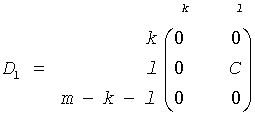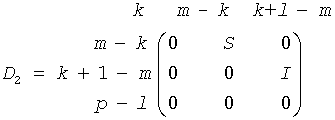Computes the generalized SVD of two upper triangular or trapezoidal matrices.
Syntax
FORTRAN 77:
call stgsja(jobu, jobv, jobq, m, p, n, k, l, a, lda, b, ldb, tola, tolb, alpha, beta, u, ldu, v, ldv, q, ldq, work, ncycle, info)
call dtgsja(jobu, jobv, jobq, m, p, n, k, l, a, lda, b, ldb, tola, tolb, alpha, beta, u, ldu, v, ldv, q, ldq, work, ncycle, info)
call ctgsja(jobu, jobv, jobq, m, p, n, k, l, a, lda, b, ldb, tola, tolb, alpha, beta, u, ldu, v, ldv, q, ldq, work, ncycle, info)
call ztgsja(jobu, jobv, jobq, m, p, n, k, l, a, lda, b, ldb, tola, tolb, alpha, beta, u, ldu, v, ldv, q, ldq, work, ncycle, info)
Fortran 95:
call tgsja(a, b, tola, tolb, k, l [,u] [,v] [,q] [,jobu] [,jobv] [,jobq] [,alpha] [,beta] [,ncycle] [,info])
C:
lapack_int LAPACKE_stgsja( int matrix_order, char jobu, char jobv, char jobq, lapack_int m, lapack_int p, lapack_int n, lapack_int k, lapack_int l, float* a, lapack_int lda, float* b, lapack_int ldb, float tola, float tolb, float* alpha, float* beta, float* u, lapack_int ldu, float* v, lapack_int ldv, float* q, lapack_int ldq, lapack_int* ncycle );
lapack_int LAPACKE_dtgsja( int matrix_order, char jobu, char jobv, char jobq, lapack_int m, lapack_int p, lapack_int n, lapack_int k, lapack_int l, double* a, lapack_int lda, double* b, lapack_int ldb, double tola, double tolb, double* alpha, double* beta, double* u, lapack_int ldu, double* v, lapack_int ldv, double* q, lapack_int ldq, lapack_int* ncycle );
lapack_int LAPACKE_ctgsja( int matrix_order, char jobu, char jobv, char jobq, lapack_int m, lapack_int p, lapack_int n, lapack_int k, lapack_int l, lapack_complex_float* a, lapack_int lda, lapack_complex_float* b, lapack_int ldb, float tola, float tolb, float* alpha, float* beta, lapack_complex_float* u, lapack_int ldu, lapack_complex_float* v, lapack_int ldv, lapack_complex_float* q, lapack_int ldq, lapack_int* ncycle );
lapack_int LAPACKE_ztgsja( int matrix_order, char jobu, char jobv, char jobq, lapack_int m, lapack_int p, lapack_int n, lapack_int k, lapack_int l, lapack_complex_double* a, lapack_int lda, lapack_complex_double* b, lapack_int ldb, double tola, double tolb, double* alpha, double* beta, lapack_complex_double* u, lapack_int ldu, lapack_complex_double* v, lapack_int ldv, lapack_complex_double* q, lapack_int ldq, lapack_int* ncycle );
Include Files
The FORTRAN 77 interfaces are specified in the mkl_lapack.fi and mkl_lapack.h include files, the Fortran 95 interfaces are specified in the lapack.f90 include file, and the C interfaces are specified in the mkl_lapacke.h include file.
Description
The routine computes the generalized singular value decomposition (GSVD) of two real/complex upper triangular (or trapezoidal) matrices A and B. On entry, it is assumed that matrices A and B have the following forms, which may be obtained by the preprocessing subroutine ?ggsvp from a general m-by-n matrix A and p-by-n matrix B:



where the k-by-k matrix A12 and l-by-l matrix B13 are nonsingular upper triangular; A23 is l-by-l upper triangular if m-k-l ≥0, otherwise A23 is (m-k)-by-l upper trapezoidal.
On exit,
UH*A*Q = D1*(0 R), VH*B*Q = D2*(0 R),
where U, V and Q are orthogonal/unitary matrices, R is a nonsingular upper triangular matrix, and D1 and D2 are "diagonal" matrices, which are of the following structures:
If m-k-l ≥0,



where
C = diag(alpha(k+1),...,alpha(k+l))
S = diag(beta(k+1),...,beta(k+l))
C2 + S2 = I
R is stored in a(1:k+l, n-k-l+1:n ) on exit.
If m-k-l < 0,



where
C = diag(alpha(K+1),...,alpha(m)),
S = diag(beta(K+1),...,beta(m)),
C2 + S2 = I
On exit,  is stored in a(1:m, n-k-l+1:n ) and R33 is stored
is stored in a(1:m, n-k-l+1:n ) and R33 is stored
in b(m-k+1:l, n+m-k-l+1:n ).
The computation of the orthogonal/unitary transformation matrices U, V or Q is optional. These matrices may either be formed explicitly, or they may be postmultiplied into input matrices U1, V1, or Q1.
Input Parameters
The data types are given for the Fortran interface. A <datatype> placeholder, if present, is used for the C interface data types in the C interface section above. See C Interface Conventions for the C interface principal conventions and type definitions.
- jobu
CHARACTER*1. Must be 'U', 'I', or 'N'.
If jobu = 'U', u must contain an orthogonal/unitary matrix U1 on entry.
If jobu = 'I', u is initialized to the unit matrix.
If jobu = 'N', u is not computed.
- jobv
CHARACTER*1. Must be 'V', 'I', or 'N'.
If jobv = 'V', v must contain an orthogonal/unitary matrix V1 on entry.
If jobv = 'I', v is initialized to the unit matrix.
If jobv = 'N', v is not computed.
- jobq
CHARACTER*1. Must be 'Q', 'I', or 'N'.
If jobq = 'Q', q must contain an orthogonal/unitary matrix Q1 on entry.
If jobq = 'I', q is initialized to the unit matrix.
If jobq = 'N', q is not computed.
- m
INTEGER. The number of rows of the matrix A (m ≥ 0).
- p
INTEGER. The number of rows of the matrix B (p ≥ 0).
- n
INTEGER. The number of columns of the matrices A and B (n ≥ 0).
- k, l
INTEGER. Specify the subblocks in the input matrices A and B, whose GSVD is computed.
- a,b,u,v,q,work
REAL for stgsja
DOUBLE PRECISION for dtgsja
COMPLEX for ctgsja
DOUBLE COMPLEX for ztgsja.
Arrays:
a(lda,*) contains the m-by-n matrix A.
The second dimension of a must be at least max(1, n).
b(ldb,*) contains the p-by-n matrix B.
The second dimension of b must be at least max(1, n).
If jobu = 'U', u(ldu,*) must contain a matrix U1 (usually the orthogonal/unitary matrix returned by ?ggsvp).
The second dimension of u must be at least max(1, m).
If jobv = 'V', v(ldv,*) must contain a matrix V1 (usually the orthogonal/unitary matrix returned by ?ggsvp).
The second dimension of v must be at least max(1, p).
If jobq = 'Q', q(ldq,*) must contain a matrix Q1 (usually the orthogonal/unitary matrix returned by ?ggsvp).
The second dimension of q must be at least max(1, n).
work(*) is a workspace array.
The dimension of work must be at least max(1, 2n).
- lda
INTEGER. The leading dimension of a; at least max(1, m).
- ldb
INTEGER. The leading dimension of b; at least max(1, p).
- ldu
INTEGER. The leading dimension of the array u .
ldu ≥ max(1, m) if jobu = 'U'; ldu ≥ 1 otherwise.
- ldv
INTEGER. The leading dimension of the array v .
ldv ≥ max(1, p) if jobv = 'V'; ldv ≥ 1 otherwise.
- ldq
INTEGER. The leading dimension of the array q .
ldq ≥ max(1, n) if jobq = 'Q'; ldq ≥ 1 otherwise.
- tola, tolb
REAL for single-precision flavors
DOUBLE PRECISION for double-precision flavors.
tola and tolb are the convergence criteria for the Jacobi-Kogbetliantz iteration procedure. Generally, they are the same as used in ?ggsvp:
tola = max(m, n)*|A|*MACHEPS,
tolb = max(p, n)*|B|*MACHEPS.
Output Parameters
- a
On exit, a(n-k+1:n, 1:min(k+l, m)) contains the triangular matrix R or part of R.
- b
On exit, if necessary, b(m-k+1: l, n+m-k-l+1: n)) contains a part of R.
- alpha, beta
REAL for single-precision flavors
DOUBLE PRECISION for double-precision flavors.
Arrays, DIMENSION at least max(1, n). Contain the generalized singular value pairs of A and B:
alpha(1:k) = 1,
beta(1:k) = 0,
and if m-k-l ≥ 0,
alpha(k+1:k+l) = diag(C),
beta(k+1:k+l) = diag(S),
or if m-k-l < 0,
alpha(k+1:m)= C, alpha(m+1:k+l)=0
beta(K+1:M) = S,
beta(m+1:k+l) = 1.
Furthermore, if k+l < n,
alpha(k+l+1:n)= 0 and
beta(k+l+1:n) = 0.
- u
If jobu = 'I', u contains the orthogonal/unitary matrix U.
If jobu = 'U', u contains the product U1*U.
If jobu = 'N', u is not referenced.
- v
If jobv = 'I', v contains the orthogonal/unitary matrix U.
If jobv = 'V', v contains the product V1*V.
If jobv = 'N', v is not referenced.
- q
If jobq = 'I', q contains the orthogonal/unitary matrix U.
If jobq = 'Q', q contains the product Q1*Q.
If jobq = 'N', q is not referenced.
- ncycle
INTEGER. The number of cycles required for convergence.
- info
INTEGER.
If info = 0, the execution is successful.
If info = -i, the i-th parameter had an illegal value.
If info = 1, the procedure does not converge after MAXIT cycles.
Fortran 95 Interface Notes
Routines in Fortran 95 interface have fewer arguments in the calling sequence than their FORTRAN 77 counterparts. For general conventions applied to skip redundant or restorable arguments, see Fortran 95 Interface Conventions.
Specific details for the routine tgsja interface are the following:
- a
Holds the matrix A of size (m,n).
- b
Holds the matrix B of size (p,n).
- u
Holds the matrix U of size (m,m).
- v
Holds the matrix V of size (p,p).
- q
Holds the matrix Q of size (n,n).
- alpha
Holds the vector of length n.
- beta
Holds the vector of length n.
- jobu
If omitted, this argument is restored based on the presence of argument u as follows:
jobu = 'U', if u is present,
jobu = 'N', if u is omitted.
If present, jobu must be equal to 'I' or 'U' and the argument u must also be present.
Note that there will be an error condition if jobu is present and u omitted.
- jobv
If omitted, this argument is restored based on the presence of argument v as follows:
jobv = 'V', if v is present,
jobv = 'N', if v is omitted.
If present, jobv must be equal to 'I' or 'V' and the argument v must also be present.
Note that there will be an error condition if jobv is present and v omitted.
- jobq
If omitted, this argument is restored based on the presence of argument q as follows:
jobq = 'Q', if q is present,
jobq = 'N', if q is omitted.
If present, jobq must be equal to 'I' or 'Q' and the argument q must also be present.
Note that there will be an error condition if jobq is present and q omitted.